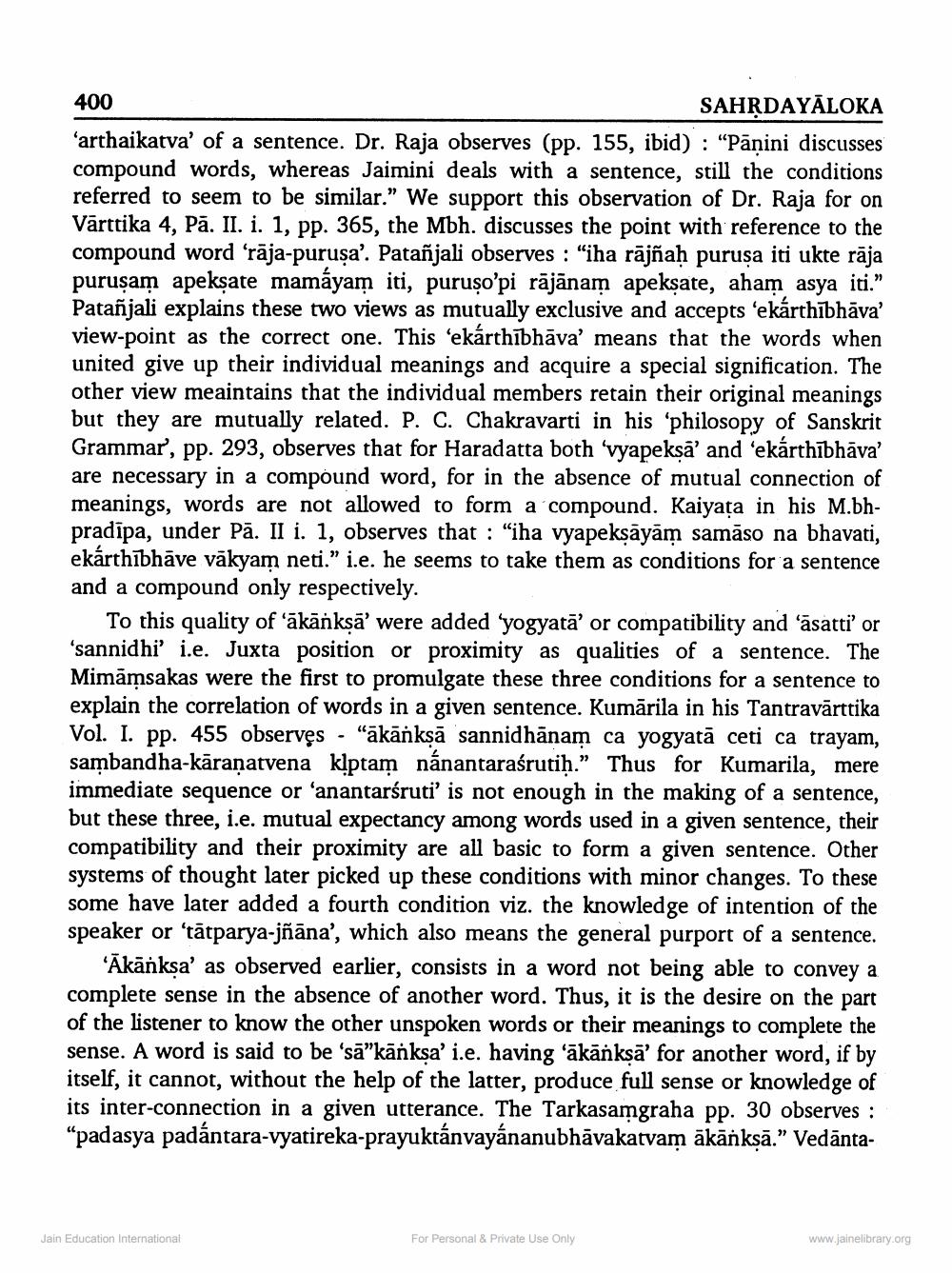________________
400
SAHRDAYĀLOKA 'arthaikatva' of a sentence. Dr. Raja observes (pp. 155, ibid): "Pānini discusses compound words, whereas Jaimini deals with a sentence, still the conditions referred to seem to be similar.” We support this observation of Dr. Raja for on Vārttika 4, Pā. II. i. 1, pp. 365, the Mbh. discusses the point with reference to the compound word 'rāja-puruşa’. Patañjali observes : "iha rājñaḥ purusa iti ukte rāja puruşam apekṣate mamayam iti, purușo’pi rājānam apeksate, aham asya iti.” Patañjali explains these two views as mutually exclusive and accepts 'ekárthībhāva' view-point as the correct one. This fekárthībhāva' means that the words when united give up their individual meanings and acquire a special signification. The other view meaintains that the individual members retain their original meanings but they are mutually related. P. C. Chakravarti in his 'philosopy of Sanskrit Grammar, pp. 293, observes that for Haradatta both 'vyapeksa' and 'ekárthībhāva are necessary in a compound word, for in the absence of mutual connection of meanings, words are not allowed to form a compound. Kaiyata in his M.bhpradipa, under Pā. II i. 1, observes that : "iha vyapeksāyām samāso na bhavati, ekárthībhāve vākyam neti." i.e. he seems to take them as conditions for a sentence and a compound only respectively.
To this quality of 'ākāńksā' were added 'yogyatā' or compatibility and 'āsatti' or 'sannidhi' i.e. Juxta position or proximity as qualities of a sentence. The Mimāmsakas were the first to promulgate these three conditions for a sentence to explain the correlation of words in a given sentence. Kumārila in his Ta Vol. I. pp. 455 observęs - "ākānksā sannidhānam ca yogyatā ceti ca trayam, sambandha-karanatvena klptam nánantaraśrutih." Thus for Kumarila, mere immediate sequence or 'anantarśruti' is not enough in the making of a sentence, but these three, i.e. mutual expectancy among words used in a given sentence, their compatibility and their proximity are all basic to form a given sentence. Other systems of thought later picked up these conditions with minor changes. To these some have later added a fourth condition viz. the knowledge of intention of the speaker or ‘tātparya-jñāna', which also means the general purport of a sentence.
Ākāńksa' as observed earlier, consists in a word not being able to convey a complete sense in the absence of another word. Thus, it is the desire on the part of the listener to know the other unspoken words or their meanings to complete the sense. A word is said to be 'sā”kāńksa' i.e. having 'ākāńksā' for another word, if by itself, it cannot, without the help of the latter, produce full sense or knowledge of its inter-connection in a given utterance. The Tarkasamgraha pp. 30 observes : "padasya padántara-vyatireka-prayuktánvayánanubhāvakatvam ākānkṣā.” Vedānta
Jain Education International
For Personal & Private Use Only
www.jainelibrary.org




